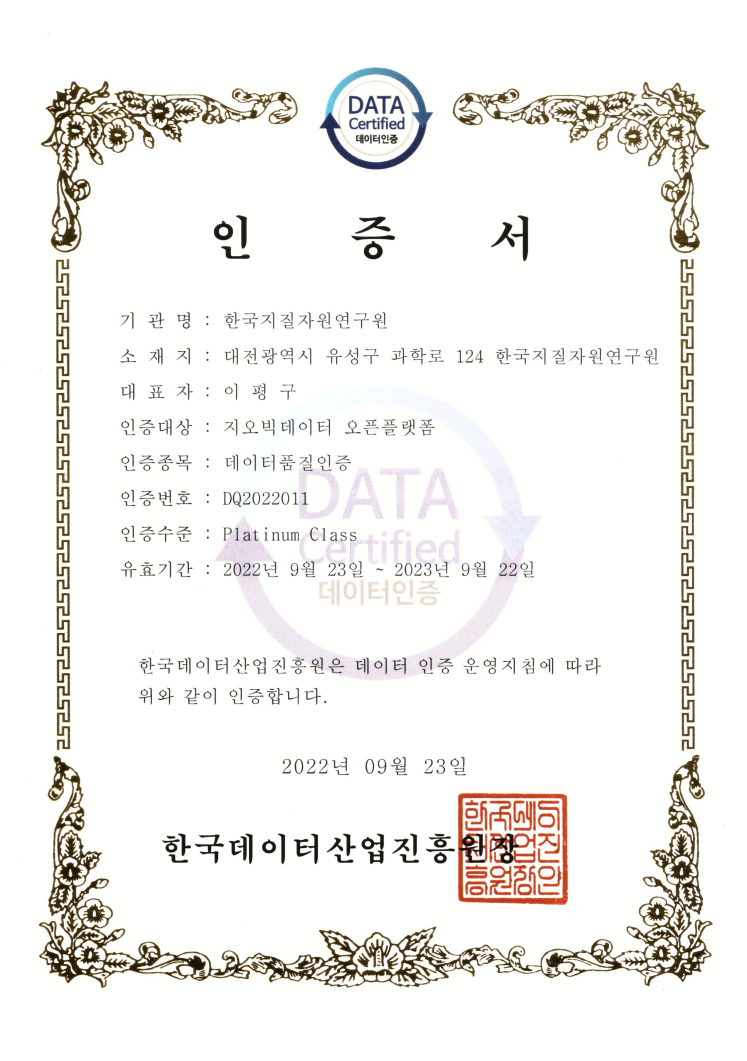도로변(서울시 및 일부고속도로 주변)의 유독 중금속 및 유기물질의 오염평가연구
상세정보
| 자료유형 | KIGAM 보고서 |
|---|---|
| 서명 | 도로변(서울시 및 일부고속도로 주변)의 유독 중금속 및 유기물질의 오염평가연구 |
| 저자 | 이평구 |
| 언어 | KOR |
| 청구기호 | KR-98-[B]-36-1998-R |
| 발행사항 | 과학기술부, 1999 |
| 초록 | Gully pots are a part of a drainage system to buffer runoff water fluxes from road to rivers and to minimize environmental pollution by keeping pollutants from spreading over the surrounding area. A series of studies have been carried out concerning the physicochemical characteristics of the sediments (sewage sludge) settling down in such a gully pot to evaluate the contamination for heavy metals such as Pb, Zn, Cu and Cd. The contaminated sewage sludges and some roadside soil from Honam and Kyeongbu Highways were also studied for comparison. The roadside soil and sewage sludge samples from gully pots were characterized by the XRD analyses and the sequential extraction experiments. Sewage sludges are characterized by very high concentrations of heavy metals (mean concentrations: Zn 2595.7㎍/g ; Cd 9.8㎍/g ; Cu 602.5㎍/g) ; Pb 265.0㎍/g), probably because of a long-term accumulation of vehicle- and industrial-related pollutants. Mean Zn concentration in Yeouido (3873㎍/g) and Junggu (3262㎍/g) areas is 4-5 times higher than those in Dobonggu area. This suggests that Zn may be derived from the source of automobile traffic (the rubber of automobile tires). The mean concentrations of Cu and Cr are very significantly high in Junggu and Gurogu areas and indicated that the industrial activities may contribute to the accumulation of Cu and Cr in sewage sludge. The low Pb levels throughtout the whole study areas in Seoul can be accounted for the use of unleaded gasoline since 1987. Sequential extraction experiments illustrate that a major part of Zn is bound to FII and FIII, representing about 88% of the total Zn concentration. Fraction IV, related to organic matter, is mostly significant for Cu accounting for 60% fo the total Cu and FII is next in importance. The main carriers of Pb are the fractions III, II and FIV, and in that order. The behavior of Cd is quite different from other elements (Zn, Cu, Pb) and most of the Cd is assoicated with FV. The possibility of heavy metal pollution by contaminated sewage sludge and roadside soils was studied using TCLP test. The Cd, Pb and As concentrations in all leachates were well below the regulatory level. But, Zn, Mn and Cu were found potential much more labile than Pb. As deduced from both sequential extraction and leaching experiments (TCLP), the relative mobility of heavy metals is found to be: Mn>Zn>Cu≥Cd>Co>Cr>Pb>Fe, in spite of large differences in heavy metal contents and localizations. Changes in the physicochemical environments (such as acidification) caused by a traffic accident may result in the severe environmental pollution of heavy metals (such as Zn, Cu) of surrounding area (surface water and rivers). 도로변에 설치된 빗물받이는 drainage system의 일부분으로 우기에 빗물의 양을 조절하고 고속도로 노면에서 운반된 오염된 입자를 침전시키기 위해 설치되었다. 도로변 먼지와 토양의 중금속오염을 평가하기 위해 서울시 중구, 구로구, 여의도 및 도봉구에서 79개 하수슬러지가 채취되었으며 비교하기 위해 호남 및 경부 고속도로의 도로변 토양을 채취하였다. 서울시에서 채취된 하수슬러지의 평균 중금속량은 매우 높다. (평균함량 : Zn 2595.7㎍/g ; Cd 9.8㎍/g ; Cu 602.5㎍/g). 연구조사된 지역 중에서 가장 높은 Zn 함량을 보이는 곳은 영등포구 여의도(평균함량 : 3873㎍/g)와 중구(평균함량 : 3262㎍/g)이며 도봉구의 평균함량보다 4-5배 높게 나타났다. Zn 오염은 자동차 타이머의 마모가 주요 오염원임을 지시한다. Cu와 Cr 오염이 심한 곳은 중구와 구로구인 것으로 분석되었으며 이는 주변의 산업활동에 기인된 것을 지시한다. Pb 오염은 외국에서 연구된 결과와 비교할 때 매우 낮은 함량을 보이며 이는 1988년부터 유연 휘발유의 사용을 금지한 결과로 해석되어 진다. Sequential extraction methods를 이용하여 분석한 결과, Zn은 FII와 FIII와 수반되는 경향이 매우 높다 (전체 Zn 함량의 88%). Cu는 주로 FIV에 대부분이 수반되며 (전체 함량의 60%), 그 다음으로 FII(전체 함량의 19%)가 중요한 운반자 역할을 한다. Pb는 주로 FIII, FII 및 FIV에서 검출되었으며, 전체 Pb 함량의 85%를 차지한다. Zn, Cu, Pb와 달리, Cd는 FV에 수반된다. TCLP test 결과, 용출된 Cd, Pb 및 As의 농도는 TCLP의 regulatory level를 초과되지 않는 반면에 Zn은 9.37-245.7mg/L, Cu는 0.002-14.860mg/L가 수용액에 용해되었다. 산성용액(산성비, 산업용폐수)이 빗물받이에 유입될 경우 중금속 (특히, Zn과 Cu)의 용출이 매우 우려할 수준에 도달할 수 있다는 것을 지시한다. 용출실험과 sequential extraction 연구결과를 종합하면 오염된 도로변 토양이 산성비와 반응할 경우 금속이온의 상대적인 mobility는 Mn>Zn>Cu≥Cd>Co>Cr>Pb>Fe의 순서이다. 프랑스의 하수슬러지의 토양투입기준과 비교하면, 중구와 여의도에서 채취된 하수슬러지의 대부분의 Zn 함량이 기준을 초과하여 농업용으로 이용될 수 없다. Cu의 경우, 채취된 시료 중에서 기준을 초과한 시료는 전체의 12%가 농업용으로 사용이 불가능하였다. 도로에서 자동차사고 등에 의해 야기될 수 있는 빗물받이의 퇴적물(하수슬러지)과 지표수의 물리화학적 변화(특히, pH변화)에 따른 환경변화는 Zn과 Cu의 상당량이 용해되어 지표수 및 강물을 오염시킬 것으로 예상된다. |
| 페이지 | 83 p. |
| 키워드 | 도로변, 서울시, 고속도로, 중금속, 유기물질, 오염, 하수, 슬러지, 토양, 중구, 구로구, 여의도, 도봉구, 미량원소 |
| 원문 |
http://library.kigam.re.kr/report/1998/도로변서울시및일부고속도로주변의유독중금속및유기물질의오염평가연구.pdf |
유형별 보고서
- 3145view
- 39download
- 관리자
- 한국지질자원연구원
- 등록일
- 1999-07-05
Share
Cite as
이평구. (1999). 도로변(서울시 및 일부고속도로 주변)의 유독 중금속 및 유기물질의 오염평가연구. 과학기술부.

댓글